Adam Yamey's Blog: YAMEY, page 65
January 5, 2024
An old white painted temple in the heart of Bangalore and a reformer of Hinduism
WHILE WALKING ALONG Bangalore’s Avenue Road, which runs from City (KR) Market to Palace Road, I spotted a mandir (Hindu Temple) down a side street. It was painted white, and its facade was surmounted by three tall niches, each containing a sculpture.
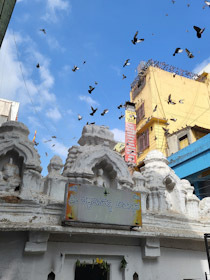
So many layers of paint had been applied over the years that the details on the sculptures had disappeared from view. At the rear of the mandir, I saw a tower like structure – part of the mandir’s roof. This was a popular landing place for pigeons. Within the building there were crudely carved stone pillars supporting the ceiling. These looked very old. Two rows of pillars lined a central ‘aisle’ leading to a shrine at the far end of the temple.
Above the entrance, there was a sign written in the script of the Kannada language, which I am unable to read. I showed a photograph of this sign to a bearer (waiter) in the dining room of the Bangalore Club. He deciphered it for me. The mandir is ‘Sri Belli Basavanna Devasthana”. This means ‘The Sri Basavanna Silver Temple’. Located in Basavannagudi Street in the Chickpet district, this is one of the oldest mandirs in Bangalore.
Born in Karnataka, Basavanna lived from 1131-1196 AD. A Shaivite (follower of Shiva) and social reformer, he was a founder of Lingayatism. His reforms included rejection of both social and gender discrimination. According to Wikipedia:
“Basava championed devotional worship that rejected temple worship and rituals led by Brahmins and replaced it with personalized direct worship of Shiva through practices such as individually worn icons and symbols like a small linga (sic). This approach brought Shiva’s presence to everyone and at all times, without gender, class or caste discrimination.”
Thus, we can see that Basava(nna) was a forward thinking person. He made religious worship personal rather than mediated by caste-conscious Brahmins.
Had my eye not been attracted by the flocks of pigeons flying around the small white mandir, it might have been many years before I became aware of Basavanna and his important ‘democratisation‘ of Hinduism.
January 4, 2024
A club founded for Indians in Bangalore
THE CENTURY CLUB in Bangalore is so-named because when it was founded in 1917 it was decided to limit its membership to one hundred. Today, the Club has about 6000 members. According to the Club’s website it was founded by the highly esteemed Sir M. Visvesvaraya (‘SMV’) who: “… was keen to promote what he felt was good in English society, particularly their orderly habits, punctuality, restraint in speech and social behaviour.”
The Club was founded during an era when Indians were not allowed to join or even enter the clubs (such as the Bangalore Club and the Madras Club), which were designed to be social clubs for the exclusive use of elite Britishers.
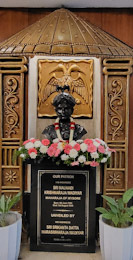 Shri Nalwadi Krishnaraja Wodeyar
Shri Nalwadi Krishnaraja WodeyarSMV was inspired to establish a social club that admitted Indians after an unpleasant incident at the Bangalore Club. It occurred when SMV was the Diwan (Prime Minister) of the Kingdom of Mysore. When one day he was invited to the Bangalore Club he was wearing the royal turban of Mysore. The staff asked him to remove it and wear an ordinary cap instead. This insulting request upset him greatly, and led to him founding a club for ‘gentlemen’, which would accept Indians. Thus, the Century Club was born.
Shri Nalwadi Krishnaraja Wodeyar, the king of Mysore, allotted 7 acres of Cubbon Park for the use of the Century Club. Today, the Club is an oasis of peace and greenery in a city that is becoming increasingly less peaceful and disturbingly less green.
The Century Club began admitting Indians in 1917. Not far away, the Bangalore Club only began admitting Indians when India became independent (in 1947), or after that. And even worse, a few other Clubs (and other institutions) continued to admit only British (and other fair skinned Europeans) until the 1960s or later. This was quite remarkable in a country that had struggled for many years to free itself from foreign rule.
January 3, 2024
In the pink
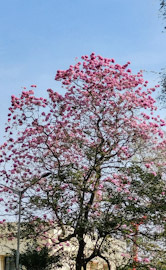 In Bangalore
In Bangalore Flaunting blossoms
High above the busy city street
They’re all bright pink
January 2, 2024
New Year’s Eve in Belgrade and Bangalore

ONE YEAR DURING THE 1980s, I was in Belgrade, then the capital of Yugoslavia, on New Year’s Eve. I was staying with my good friend Raša Raićevič. He suggested that we should see in the new year at a friend’s flat I New Belgrade.
Before we set off from his flat in the older part of the city, Raša warned me to keep away from windows and off the terrace as the midnight hour approached. In the 1980s, many retired military people resided in New Belgrade, and quite a few of them possessed firearms. It was customary in those days to fire the guns at the moment a new year commenced. The risk was that ricocheting bullets might break windows or hit people out on their terraces and balconies. Fortunately, we survived the evening without mishaps, and spent the first few hours of the new year at another friend’s home, a long taxi ride away from New Belgrade.
Many years later, sometime after 2006, we were in Bangalore over New Year. My wife and I stayed at home with my recently widowed mother-in-law, who was too frail to attend a party. Everyone else in the family went out to celebratory parties.
The three of us, who remained at home, decided that we would sit together until midnight. However, by about 10 pm on the 31st of December, we all fell asleep. It was only when our daughter phoned us at 3 am that we realised we had slept through the transition from one year to the next.
My New Year’s Eve spent in Belgrade was a complete contrast to that which we slept through in Bangalore. This evening, we plan to have a slap-up dinner followed by drinks under the stars high above the city of Bangalore. I hope that all of you, dear readers, will have a great 2024.
January 1, 2024
Shops and shrines on a busy road in old Bangalore
I KNOW OF TWO Avenue Roads. One is in London. Lined with the homes of the wealthy, it runs between Swiss Cottage and Regents Park. The other one is in Bangalore. It runs between KR Market (aka City Market) and a large Hindu temple (mandir) where Kempe Gowda Road becomes District Office Road. Both the road in London and its namesake in Bangalore carry much traffic, but there the similarity ends.
Avenue Road in Bangalore (‘AR’) is mainly lined with all kinds of shops, especially those dealing in paper goods (stationery as well as printed books). It runs through one of the oldest parts of the city: Chickpet. The lines of shops are punctuated by small lanes and alleys that lead away from AR.
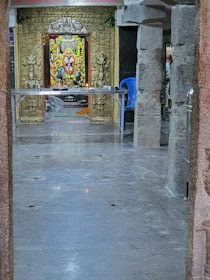 Old pillars in a mandir on Avenue Road in Bangalore
Old pillars in a mandir on Avenue Road in Bangalore As you stroll along the thoroughfare, you will pass mandirs and one church. And near the KR Market end of the road, a short lane leads to a Muslim shrine, the Dargah-e-Hazrath Manik Mastan Sha Saherwadi. It is well worth removing your footwear to enter this peaceful place. The grave it contains is in a small room with a mirrored, domed ceiling.
Some of the mandirs on or near AR are also worth looking into. Although some of their facades look fairly recent, the carved stone columns within the buildings look quite old. Near the street entrance of one of the mandirs on AR, I saw two intricate stone carvings of Hindu subjects. Both looked as if they might have been carved several centuries ago.
The Rice Memorial Church stands in its own small grounds, separated more from its neighbours than the mandirs on AR. Named after the British missionary, the Rev Benjamin Holt Rice, this Church of South India place of worship was built between 1913 and 1916 on the site of an earlier chapel first constructed in 1834, and then later rebuilt before being demolished. Although I have passed it often, I have not yet been able to enter it.
Not far from the church and a couple of picturesque mandirs, there is a branch of the Kamat chain of eateries. You can stop there for snacks and a variety of beverages. This place is in the midst of the numerous bookshops on AR. Proclaiming discounted books, these stores mainly stock textbooks and computer programming instruction manuals. Incidentally, AR is a good place to find a wide variety of diaries and calendars.
Bustling Avenue Road in Bangalore is a far more colourful and interesting thoroughfare than its rather elegant but staid namesake more than 5000 miles away in London. The street in Bangalore and the lanes leading off it give one a good idea of the ‘flavour’ of the parts of the city which existed before the arrival of the British imperialists. It makes a fascinating contrast to the newer Cantonment areas that became established after the British began settling in Bangalore.
December 31, 2023
Protesting about lettering in Bangalore
Happy New Year!
KANNADA IS THE language spoken by the indigenous people of the Indian State of Karnataka. It is a Dravidian language spoken by about 44 million ‘natives’ of Karnataka and a 2nd or 3rd language for about 15 million ‘non-natives’.
The city of Bangalore is home to many people who either know no Kannada or for whom the language is not their ‘mother tongue’. Consequently many shop signs in the city either have no Kannada or have both English and Kannada lettering.
At the end of February 2024, it will be a legal obligation for all shop signs in Karnataka to have at least 60% of their coverage in Kannada script (currently, the requirement is 50%). However, for some fanatic Kannada nationalists this is not soon enough. On the 27th of December 2023, a few lorries loaded with men toured Bangalore. They stopped outside shops and attempted, often successfully, to damage or destroy the English lettering on shop signs. They did this not only to those signs which were entirely in the English script, but also to some bilingual signs (I.e., signs with both English and Kannada script). Not only did they damage or disfigure the English script, but in some cases, they also smashed windows.
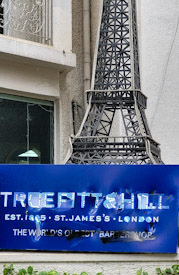 Defaced shop sign
Defaced shop signThe police attempted to restrain these pro-Kannada activists. A few of them have been arrested. However, two days later I read that further unrest in Bangalore is threatened if those who have been arrested are not released.
While I sympathise with locals being upset that many of those who have come to Karnataka from elsewhere have little or no knowledge of Kannada, vandalism is no way to promote usage of the language and its script.
December 30, 2023
Pigeons on the temple roof
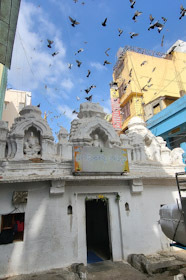
The bell tolls loudly
Within the holy mandir
Pigeons fly around
December 29, 2023
An interesting outdoor bazaar in Bangalore
AT FIRST SIGHT, you might well think that you are looking at a crowded carpark which has been blown to pieces by a powerful bomb. There are parts of cars – bodywork, tyres, engine parts, etc., – all over the place.
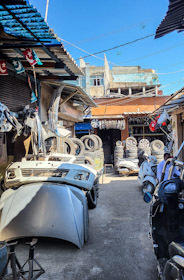
After a moment or two, you begin to realise that there is a semblance of order in this ocean of car parts, many of which have been salvaged from cars at the end of their useful lives. For this area in the Shivajinagar district of Bangalore is a car parts bazaar. There are many different dealers, each specialising in particular parts of a vehicle. For example, there are merchants selling radiator grilles, others purveying axles (both front and rear), there are sellers of tyres, there are shops selling car doors and body panels … and so on.
Near both Russell Market and St Mary’s basilica, the car parts bazaar is almost hidden from sight by the buildings surrounding it. It is approached by short gullies – narrow lanes. I first stumbled across it in late December 2007. Then, on subsequent trips to Bangalore, I tried to find it again, but in vain. Today, the 26th of December 2023, I managed to locate it, and spent a few minutes wandering around it, stopping to take photographs.
It seemed that most of the dealers were Muslims. Some of them stopped me, greeted me, and asked where I came from and my name. When I replied ‘Adam’, they asked me whether I am Muslim. This reminded me of my first visit to Kosovo in 1975. As soon as I stepped of the bus that had carried me from Skopje (Macedonia) to Prizren (Kosovo), a group of youngsters surrounded me. They wanted to know my name, and when I told them, they were very happy because they thought that, like them, I was a Muslim.
Most of the dealers in the car part bazaar were happy with my taking photographs, but a few in one section of the market asked me not to use my camera.
As far as I could see, no repair work was being undertaken in the bazaar. Nearby, next to Russell Market, there were plenty of cars being repaired. Often those involved in repairing a vehicle were engaged in noisy discussions.
It is seeing places like the seemingly shambolic car parts bazaar that help to endear India and its people to me.
December 28, 2023
A collection of colourful saree textiles in Bangalore
ONE OF THE THINGS that struck me when I first visited India in January 1994 was how everyone was wearing clothing far more colourful than anywhere else I had been before. Wherever I have been in the country, there is a feast of colourful clothing to be seen. Whether the colourful garments are worn purely for aesthetic reasons and/or for ceremonial or group identity reasons, everywhere there is much to please the eye.
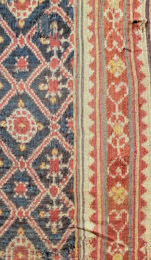
I am not alone in noticing the Indian penchant for wearing bright colours. In 1956, the famous style ‘diva’ Diana Vreeland noted in British Vogue magazine: “… pink is the navy blue of India …”. Following from this, an article in India’s “Economic Times” of January 2022, pointed out that “Red is the Indian beige and yellow is the Indian grey…”. In other words, that the exuberant colours worn by Indians contrast dramatically with the much more drab colours currently worn in the West. Actually, as my wife pointed out, long ago in Europe (eg the 18th century and before) clothes – especially those worn by the wealthy and the aristocracy – were far more colourful than now.
On the 23rd of December 2023, we were fortunate to get admission to an exhibition of sarees on its last day. Intriguingly entitled “Red Lilies, Water Birds”, the show was hosted by The Registry of Sarees in a house on Hayes Road in Bangalore. The Registry (established in 2016) is a trust set up by the Mysore Saree Udyog (founded in 1932). Its purpose is to promote the study, design, and conservation of handspun and handwoven textiles.
The nine rooms of the exhibition contained about 84 examples from the Registry’s much larger collection. Each room concentrated on either a particular region of India, or a specific method of creating the textiles. Every room was filled with sarees, which filled the viewer’s eyes with richly coloured, intricately patterned delights.
Many of the visitors to the exhibition, and the staff looking after, and explaining, the show were wearing clothing that demonstrated what I mentioned at the outset – namely, the preference of many Indians to dress colourfully.
December 27, 2023
Driving on roads on India
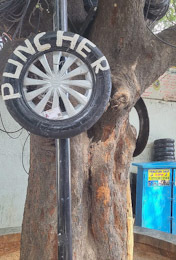
WHEN I FIRST visited India – that was in January 1994 – I carried my British and International driving licences with me. Boldly, I drove in the heavy traffic and densely crowded streets of the busy City Market area of Bangalore and also all the way to Ootacamund (‘Ooty’) – over 270 Km, and that was before the highway was constructed. You can share in these experiences by reading my book about travels in India, “The Hitler Lock & Other Tales of India”. This book/kindle is available from Amazon (https://www.amazon.co.uk/HITLER-LOCK-OTHER-TALES-INDIA/dp/B0CFM5JNX5/ ), and IF you live in India, from: https://store.pothi.com/book/adam-yamey-hitler-lock-and-other-tales-india/ .



